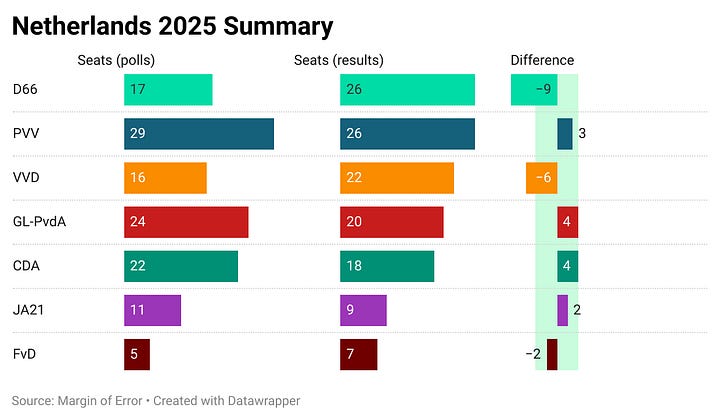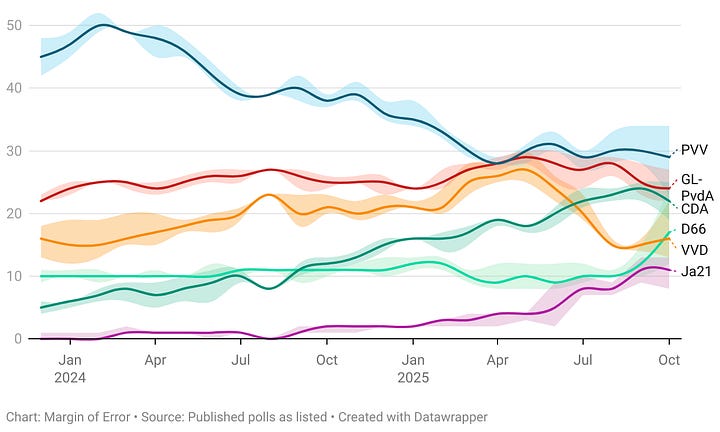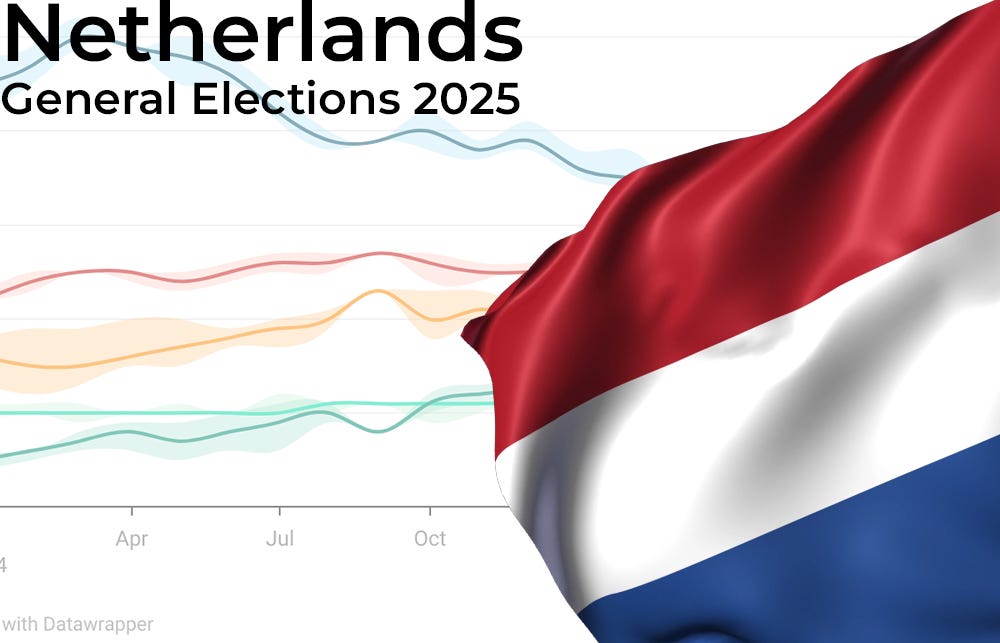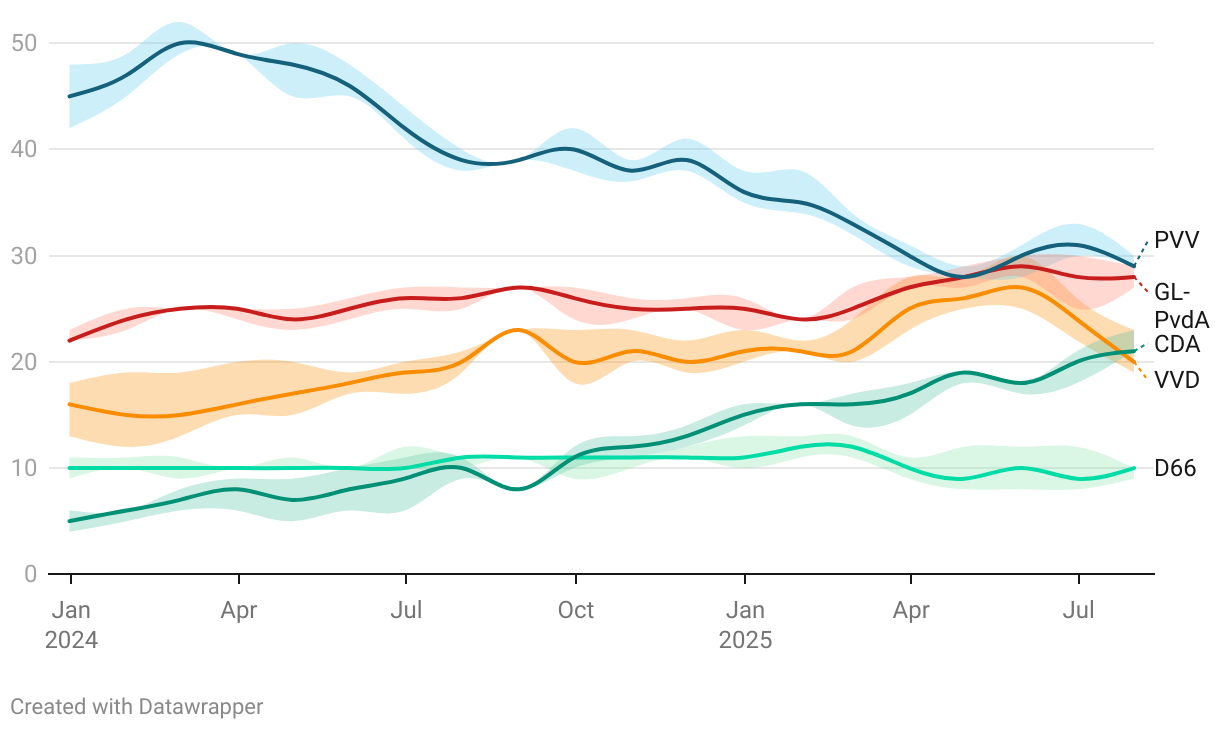Election Tracker: Netherlands General Elections 2025
Follow the trends of the 2025 Dutch General Elections here.
We originally intended to deploy our polling model for the 2026 Hungarian elections only (at least in terms of it being the first and only one this year), but we found a bit of extra time, we decided to try and convert it to the Dutch elections too.
The electoral system & the path to 76
To quickly recap, the Dutch House of Representatives (the Tweede Kamer) consists of 150 seats, distributed proportionally based on vote share and 76 seats are required for a majority. Due to the nature of the electoral system, it’s unlikely that any single party achieves majority (it hasn’t even happened yet in the modern era, last time it was in 1891), so coalition building is standard activity. As far as I know, no coalition plans have been announced in advance, so let’s explore a few scenarios.
Our model - based on July data - indicates a nail-biter race, while PVV remains the favourite despite losing considerable ground. GL-PvdA trails them closely, and we must also note the tight race for 3rd between CDA and VVD. PVV coming away from the elections again as the largest single party is certainly a possibility, even if trends are against them at this point.
Given how quickly the Schoof cabinet fell apart, the observable trends forecast an array of possibly uneasy scenarios for government forming and coalition building as interest and ideology-wise similar compositions will be difficult to achieve. As things stand a right-to-center-right PVV-VVD-CDA coalition, which would essentially be a repeat of the previous one, would likely fall short of gaining a majority (only just, with 71 seats).
While GL-PvdA could have an easier path to 76 when it comes to potential partners - having historical experience with both the CDA and the VVD, perhaps involving D66 - they would first have to overtake PVV. Even then, GL-PvdA would need their partners to pick up an extra 5 seats and a left-to-center-left coalition would also not reach majority (or even 60 seats for that matter).
We must also not forget the smaller players’ potential to become kingmakers as BBB and JA21 (for a conservative government) or SP and PvdD (for a GL-PvdA led formation) would gain about 9-13 seats, which could also be enough to support a minority government (one that just fall short of the majority) from the outside of it.
The shaded areas you see around the vote share lines represent our ‘confidence bands’ showing the full distribution of the polling data. This highlights exactly why we build our own model, to visualize the sometimes incredible distribution of polling and to reduce the noise of this range by weighting the individual results and normalizing the aggregates. While raw polling numbers would leave us confused about results that could fall anywhere in these areas, our model refines it to the most probable outcome (as always, based on what we can measure, and acknowledging that it is not a guaranteed result, upsets and unforeseen twists do happen).
Seat Projection
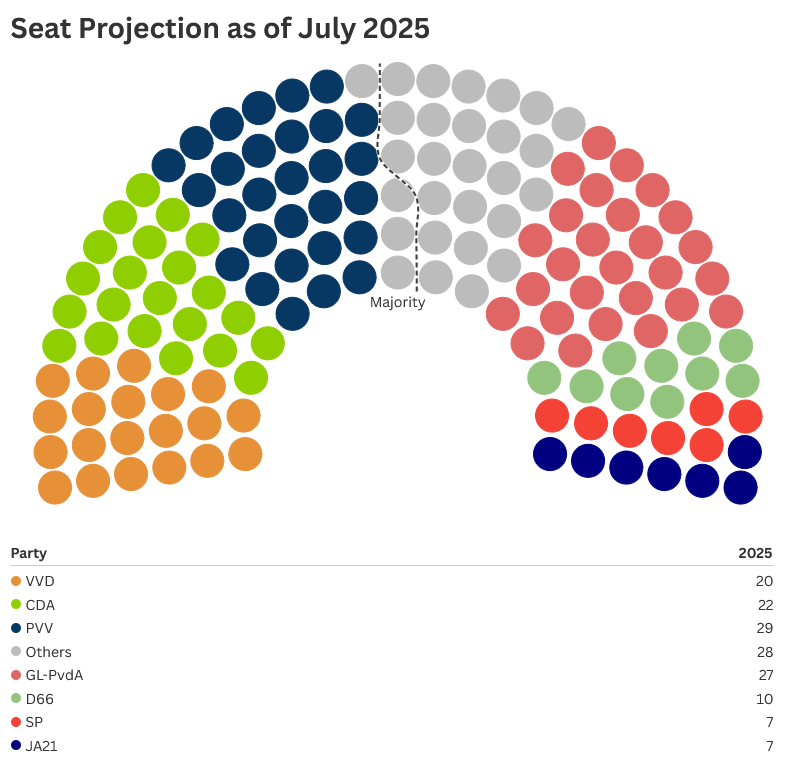
Based on this data, we also experimented with creating a seat projection using the d’Hondt method (similar to how a live election would perform allocations). Sadly granular vote share data is not readily available from all sources (for example Peil.nl doesn’t even publish them at all, or at least we didn’t find them), so we reverted back to using only our more straightforward polling model, to ensure we include all data we have access to - and we’ll shelve the projection model to use it where the context allows for such.
We believe presenting data is best done in an interactive way, so the full chart is available here for you to explore directly.
We’ll do one more update right before the election to capture as many polls published and to get as clear a picture as possible. Keep an eye out for it on our Github (which updates automatically as we add more data) and we’ll also post a note about the final pre-voting standings here.
August 2025 Update
Adding poll data from August we can see some very interesting changes compared to the last few months’ trends.
PVV widened the gap a bit from a predicted tie to a narrow lead, but the confidence bands still overlap indicating real possibilities for a reversal. VVD’s support seems to have collapsed in August and the simultaneous rise of CDA, JA21 and the gains of PVV could suggest a looming realignment as some voters might have migrated to these parties from VVD’s base. D66 and GL-PvdA didn’t produce noteworthy swings either way.
Of course in a proportional system like the Dutch, it’s not just about who’s on top, but how the rest of the pack performs - specifically those closer in ideology for coalition building - and at the moment things the right-from-center part of the spectrum has more reasons to look forward to election day. We’ll see how the last few weeks shape the field.

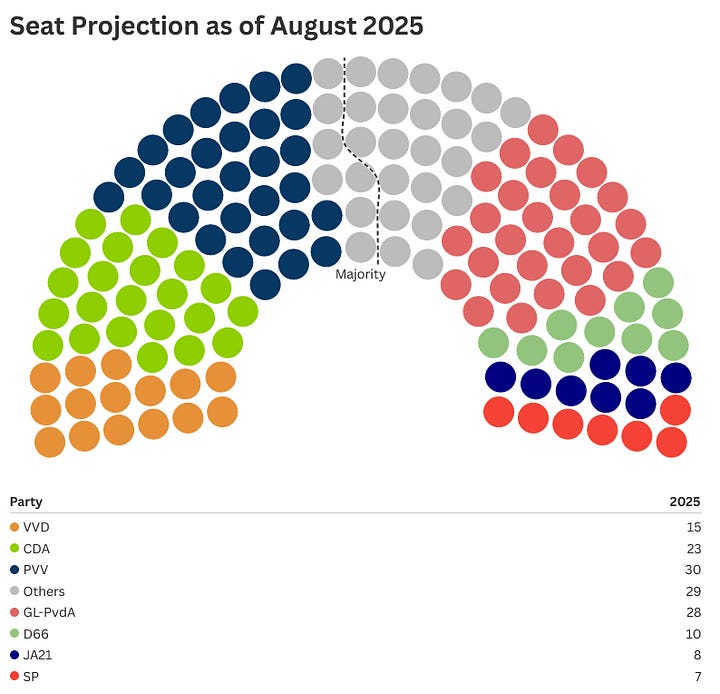
September 2025 Update
The race continues to be tight, as CDA might come to second place ahead of GL-PvdA; but the confidence bars overlap so theoretically despite the PVV lead it’s possible for GL-PvdA to tie the first place, or come in second ahead of CDA.
The spectacular collapse of VVD continues as D66 and Ja21 close in.
At this point a 3-way majority coalition seems impossible as both a PVV-CDA-VVD/Ja21 and (in the unlikely event of them winning) a GL-PvdA-VVD/CDA-D66/SP would fall short of a majority.
4-party coalitions are not unprecedented as it’s been the case since the 3rd Rutte cabinet in 2021 and it seems like the most likely option this time as well.
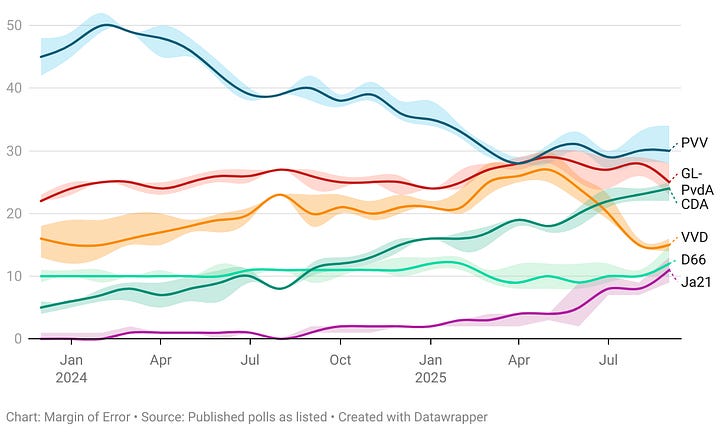

October 2025 Final Pre-Election Update


Key updates following the October additions:
the Forum voor Democratie overtook the Socialist Party and thus replaced them on our parliamentary chart as the party with the fewest seats still called out individually
the PVV solidified their lead against GL-PvdA as the latter continued to decline
With the VVD, CDA and (of course) the GL-PvdA stating that they won’t govern with the PVV, coalition building seems to be dead on arrival (assuming this stance holds after the election for the first two). With all the troubles a minority or a demissionary government would mean given recent experience (with neither side having enough seats to pass agenda comfortably) one thing seems to be sure: the saga of this election will not end with the results being announced.
Post election thoughts
So the Dutch general elections passed and boy was it a surprise. The polls unanimously prepared the electorate for a PVV victory and not only did they not win by the polled margin, they ended up coming in second. Also surprising were the results for the VVD over- and the GL-PvdA heavily under-performing. I’m not going to go into a tirade on whether polling is broken or not, I think the polls were fair in terms of aligning with the general expectations and rather a post hoc survey of what changed in the electorate could reveal why it was off the mark (plus I admit I’m not familiar with the Dutch news cycle so there may have been things pointing towards this last minute shift).
Also worth noting that generally the polls were still acceptable; on the first chart here we can see the polled results vs actual and the difference, the accepted margin of error highlighted in green (3% plus-minus, which translates roughly into 4 seats here). We can see that while it was not fully accurate, most were still in the range - except for the VVD and of course D66, the latter of which obviously being a huge election changing miss. The last poll published by Peil just a day before the election was a lot closer and the sharp uptick of D66 shows it on the chart as Peil has the best track record and therefore the highest weight (though the other October polls still skew the aggregation model away from the result).
All in all we also must not forget that polling works with fundamentally human data, often obfuscated by emotions so we shouldn’t expect it to be perfect. While missing the mark on who won understandably will make us raise questions as it should, we must remember that polling is not like looking into a crystal ball. We’ll go into why polling is hard soon in a dedicated series of posts so keep an eye out (and hit subscribe, just do it) for it if you are curious about how it works behind the scenes and just how easy it is to run into obstacles or make mistakes even if they try to do everything right
